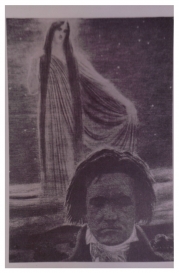Add a comment
Musical Unity and Musical Vision
‹-- PreviousNext --›
Even as a student, I was faintly perplexed by the equation of a spiritual attribute with concrete, technical details. I had a composer friend who was deeply taken by this aesthetic, and I used to ask him why, if the point about unity in great music was that it was created unconsciously, did he spend so much conscious effort constructing the motivic structure of his music? (He, on the other hand, felt I wasn’t taking our art sufficiently seriously when I upheld a valid role for whim in the compositional process.)
And, much as I relished the process of musical analysis, I did tend to feel that the basic narrative of the exercise was to demonstrate how we the analysts partook of the composer’s genius because we could identify the unifying threads that held their work together. All rather sycophantic and self-congratulatory when you get down to it.
Of course, this aesthetic has been richly critiqued over the years by what we used to call the New Musicology, and we’re just as likely these days to perceive classical music as a postmodern tapestry of topical allusions as the integrated product of a single great mind. We look at Romantic aesthetics with a bit more historical distance, too. Scott Burnham, for instance, has made a nice case that a lot of the concern with ‘unity’ and the development of analytical methods to reveal where it was hidden were in fact attempts to make sense of Beethoven’s late work. Until the most respected composer of his generation started producing stuff that challenged all existing concepts of musical coherence, you could construe ‘unity’ to mean ‘well it kinda hangs together well enough’. Beethoven’s late works required listeners to make such great imaginative leaps to make sense of what was going on, that the idea of unity started to accrue all these extra layers of poetic and spiritual association.
Now, the reason I’ve been thinking about this recently is a throw-away remark David Wright made back in the summer. He was talking about why he doesn’t like people doing ‘surgery’ on his arrangements – making cuts, or adding embellishments, or changing the tag. He said: ‘The value of an arrangement that is conceived by one mind is that it has coherence; it is not arbitrary.’ I found this striking because it mirrored so strongly the Romantic aesthetic I’d been brought up in, projecting the unitary ego of the creator onto the unified product of the work.
But it also gave a context that motivated the statement. If you work in a world where people are always jiggering with each other’s work, then it can be frustrating to see someone ride a coach and horses through your carefully-planned design without noticing what they’re destroying to introduce their cool effect. And that of course is the kind of thing the early purveyors of Romantic ideology were also railing against – the idea that you might perform exactly and only what the composer had written was incredibly radical back in 1810.
Hence, the problem with the credo of my undergraduate years is not that it was an unreasonable artistic position, it’s that people were still acting like it was a big deal 150 years after the argument had been won.
* The mark of a successful undergraduate education is of course that the graduate has developed the critical faculties to dispute everything they've been taught...











